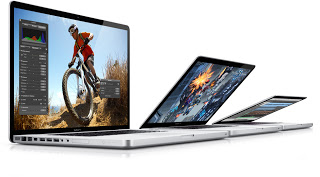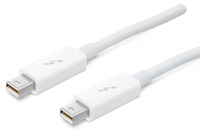Recently Apple refreshed their Macbookpro line and included Intel’s Thunderbolt communication technology
Developed by Intel (under the code name Light Peak), and brought to market with technical collaboration from Apple. Thunderbolt technology is a new, high-speed, dual-protocol I/O technology designed for performance, simplicity, and flexibility. This high-speed data transfer technology features the following:
* Dual-channel 10 Gbps per port
* Bi-directional
* Dual-protocol (PCI Express* and DisplayPort*)
TechRepublic makes the case that Wireless USB would be better than Thunderbolt.
USB 3.0 is backward compatible with the millions of existing USB peripherals as well, while Thunderbolt will require adapters to work with them. The only drawbacks to USB 3.0 versus Thunderbolt are
1.) it’s half as fast (5Gbps for USB 3.0 vs. 10Gbps for Thunderbolt) and
2.) the USB 3.0 connector is a little larger.
However, Thunderbolt, USB 3.0 and Wireless USB would all be fast enough so that you would not need a separate connection for video monitors (no VGA, DVI, or HDMI ports needed)
Wireless USB can reduce accessory cables altogether and has the potential to introduce a universal wireless docking solution.
Wireless USB can deliver on the promise of personal area network for connection keyboards, monitors, smartphones and all of your local devices and accessories.
A universal wireless docking solution would have two big effects for mobile users — it would make docks a lot cheaper and it would likely spawn a lot more places to dock.
This would be most important for smartphones and tablets or other smaller devices that replace PCs and laptops. Anywhere there was a keyboard or mouse or monitor that was Wireless USB compatible you could connect a device that could be smaller.
Barriers to even smaller devices that would still have full powered input and output would be possible. All accessories would work together with all devices. All devices (TVs, smartphones etc…) would be able to communicate without buying a combinatorial explosion of connectors.
Jason Hiner notes Intel will not step up to push Wireless USB.
Who will step up and lead the charge? NVIDIA, Qualcomm, Motorola, and Samsung or Google ?
If you liked this article, please, give it a quick review on ycombinator or StumbleUpon. Thanks

Brian Wang is a Futurist Thought Leader and a popular Science blogger with 1 million readers per month. His blog Nextbigfuture.com is ranked #1 Science News Blog. It covers many disruptive technology and trends including Space, Robotics, Artificial Intelligence, Medicine, Anti-aging Biotechnology, and Nanotechnology.
Known for identifying cutting edge technologies, he is currently a Co-Founder of a startup and fundraiser for high potential early-stage companies. He is the Head of Research for Allocations for deep technology investments and an Angel Investor at Space Angels.
A frequent speaker at corporations, he has been a TEDx speaker, a Singularity University speaker and guest at numerous interviews for radio and podcasts. He is open to public speaking and advising engagements.



